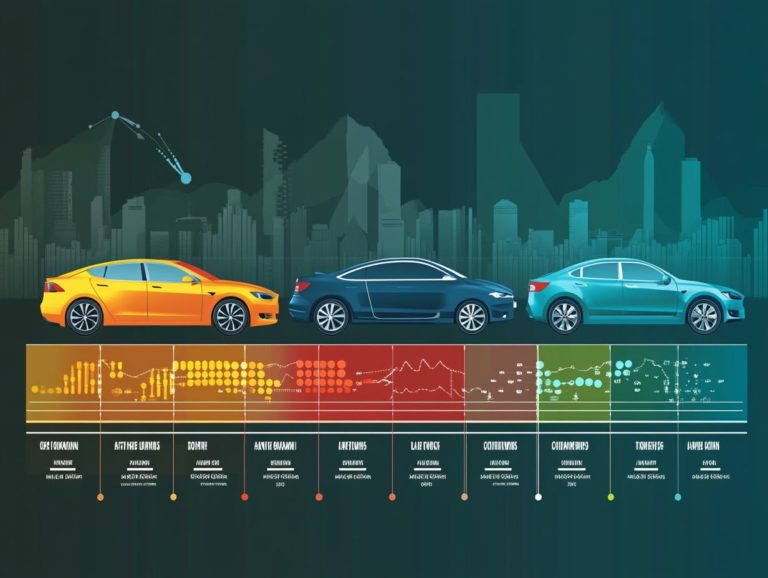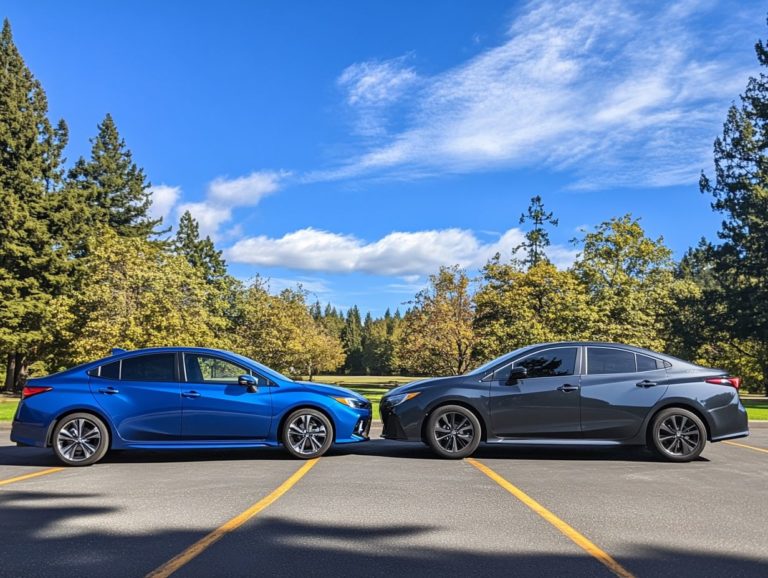Feature Comparison: Sports vs. Family Cars
When selecting a vehicle, understanding the differences between sports cars and family cars is essential.
In this guide, you’ll discover key elements that matter when choosing your next car, such as performance, design, cost, practicality, and safety features. Whether you love the thrilling speed and eye-catching looks of a sports car or the comfort and functionality of a family car, this analysis will illuminate what each type offers.
By the end, you’ll have a clear understanding of which car fits your lifestyle and needs perfectly!
Contents
- Key Takeaways:
- Performance Comparison
- Design and Features
- Cost Comparison
- Practicality and Versatility
- Safety Features
- Frequently Asked Questions
- What are the main differences between sports cars and family cars when it comes to features?
- Do sports cars and family cars have different safety features?
- How does the fuel efficiency of sports cars compare to that of family cars?
- Are there any features that both sports cars and family cars commonly share?
- Can you expect to find similar technology features in both sports cars and family cars?
- Is it possible for a car to be both a sports car and a family car?
Key Takeaways:
- Sports cars excel in speed and performance, while family cars focus on comfort and versatility.
- Sports cars generally have a higher initial cost and maintenance expenses, whereas family cars are more budget-friendly.
- Family cars often come with more safety features that help drivers avoid accidents compared to sports cars.
Defining the Two Types of Cars
In the automotive world, two main categories stand out: the mid-size sedan and the family-focused SUV or minivan. Mid-size sedans like the Honda Accord and Toyota Camry offer a great mix of driving enjoyment and everyday practicality.
SUVs and minivans, on the other hand, provide spacious interiors and cargo capacity. They cater perfectly to larger families or anyone needing extra storage. This distinction highlights the balance between sporty performance and useful function in today’s market.
If you seek a spirited driving experience, mid-size sedans often provide excellent handling and fuel efficiency. This makes them suitable for both daily commutes and exciting weekend drives.
Meanwhile, SUVs like the Ford Explorer or minivans such as the Chrysler Pacifica shine in versatility, with flexible seating and plenty of space for passengers and cargo. For families seeking safety and convenience, these larger vehicles may be more attractive.
Performance Comparison
Comparing the performance of mid-size sedans and SUVs reveals striking differences in driving dynamics and acceleration.
Sporty sedans like the BMW 3 Series and Audi A4 deliver a thrilling driving experience with exceptional handling. In contrast, models like the Honda Accord and Nissan Altima perform reliably but may lack the sporty edge.
Speed, Acceleration, and Handling
Speed, acceleration, and handling are vital factors that set a sporty mid-size sedan apart from its SUV counterparts. These elements significantly influence your driving enjoyment.
Many drivers crave that exhilarating rush of quick speed, a feeling that models like the Honda Accord Sport provide with their turbocharged engines. You might be drawn to these sedans not only for their zippy acceleration but also for their refined handling that connects you to the road.
If you have a family, however, you may prefer SUVs like the Toyota RAV4 or Ford Explorer. While robust in performance, these vehicles prioritize comfort and space over agility, making them ideal for daily life.
Design and Features
The design and features of a vehicle greatly affect your satisfaction, especially when comparing mid-size sedans to SUVs and minivans.
Mid-size sedans, with their sleek exteriors and refined interiors, captivate those who value aesthetics and comfort. They often come equipped with luxurious leather seats and advanced safety features, making them a delightful choice for the discerning driver.
On the other hand, SUVs and minivans prioritize spacious interiors and generous backseat room. They address practical needs while embracing contemporary design elements, making them an ideal option for families or anyone who seeks both functionality and style in their vehicle.
Exterior and Interior Differences
The exterior and interior differences between mid-size sedans and SUVs reveal distinct philosophies in automotive design. For example, the Sonata boasts sleek lines crafted to enhance aerodynamics and fuel efficiency, while SUVs like the Honda CR-V embrace a tall stance, offering a commanding view of the road.
Mid-size sedans typically provide a modest trunk capacity, ranging from 15 to 17 cubic feet—just enough for your daily commuting needs. In contrast, SUVs can offer over 30 cubic feet of cargo space behind the rear seats, with options to fold them down for even more room. This makes them perfect for family road trips or outdoor escapades.
Cost Comparison
When considering a vehicle, the cost comparison between mid-size sedans and SUVs is essential for those mindful of their budget. Initial costs and ongoing maintenance expenses can significantly influence purchasing decisions.
Mid-size sedans, such as the Honda Accord, generally offer lower starting prices and more manageable long-term maintenance costs compared to entry-level SUVs. However, if you’re part of a family, the added utility of an SUV might justify the higher price tag, especially when exploring financing options!
Initial Cost and Maintenance Expenses
The initial cost and maintenance expenses of vehicles are pivotal factors that can influence your choices. Reliable cars like the Toyota Camry typically boast strong resale value, while pre-owned SUVs may demand a heftier upfront investment and potentially higher maintenance costs due to their intricate systems that power the vehicle.
Sporty sedans also tend to have lower insurance premiums and better fuel efficiency, making them a smart choice for cost-conscious buyers. Maintenance costs for sedans can be significantly less than those for SUVs, which might require more frequent servicing due to their larger tires.
While SUVs generally depreciate over time, certain models—especially those from prestigious brands—can surprisingly hold their value well. Diving into reliability ratings, warranty coverage, and long-term ownership costs is essential for anyone navigating vehicle ownership.
Practicality and Versatility
Practicality and versatility are essential factors to consider when selecting a vehicle. Mid-size sedans like the Mazda6 boast impressive driving dynamics, but they often lack the cargo capacity and towing capabilities found in their SUV counterparts.
This trade-off compels you to reflect on your primary usage requirements when deciding between these categories of vehicles. Ready to discover which vehicle fits your lifestyle?
Usability for Different Purposes
Usability for different purposes ultimately determines whether a mid-size sedan or an SUV is the better choice for your needs.
When you consider family dynamics, larger vehicles like SUVs provide ample space for car seats, strollers, and family pets. They also come loaded with high-tech safety features, such as lane-keeping assist and adaptive cruise control, which help keep your young passengers safe and provide peace of mind during those long drives.
On the flip side, mid-size sedans shine with their fuel efficiency and sportier ride. However, they may not offer the versatility you need if you juggle multiple commitments. In those cases, spacious interiors and intelligent storage solutions become invaluable.
Ultimately, the differences in usability reflect a deeper understanding of your lifestyle choices, guiding you toward the most suitable option for your unique circumstances.
Safety Features
When selecting a vehicle, safety features should be a top priority, especially in mid-size sedans and family-oriented SUVs. Reliable models like the Hyundai Sonata and Ford Fusion often come equipped with high-tech safety features that elevate protection, earning them impressive safety ratings and IIHS awards.
Explore your options carefully to understand the specific safety features available in these vehicle categories. This knowledge will help you make a well-informed decision that best suits your family’s needs!
Standard and Optional Safety Features
- Advanced safety features: Many mid-size sedans, like the Honda Accord, often come equipped with advanced safety features right off the bat.
- Child safety: Certain models may offer packages enhancing child safety and overall vehicle security.
- IIHS awards: Vehicles that have received these awards can instill confidence in your purchase.
When considering family dynamics, it’s essential to explore how these features not only safeguard child occupants but also bolster the vehicle’s overall reliability. Features such as adaptive cruise control, automatic emergency braking, and rearview cameras significantly reduce potential risks on the road. The impact of these advancements goes beyond convenience; they contribute to the overall safety ratings assigned by reputable organizations.
As you weigh your options, understanding the full spectrum of these features can profoundly influence your decision-making process, ensuring peace of mind for those who prioritize safety in their driving experience.
Frequently Asked Questions
What are the main differences between sports cars and family cars when it comes to features?
Sports cars typically have more powerful engines and are designed for speed and performance, while family cars prioritize comfort and practicality.
Do sports cars and family cars have different safety features?
Generally, sports cars have more advanced safety features for high-speed driving, while family cars focus on essentials like child seat anchors and rearview cameras.
How does the fuel efficiency of sports cars compare to that of family cars?
Sports cars tend to have lower fuel efficiency due to their powerful engines, while family cars are designed for better gas mileage for everyday use.
Both types of cars often have features like air conditioning, Bluetooth connectivity, and power windows, although they may differ in quality and performance.
Can you expect to find similar technology features in both sports cars and family cars?
Yes, both types of cars may have similar technology features such as touchscreens, navigation systems, and smartphone integration, but sports cars may offer more advanced options.
Is it possible for a car to be both a sports car and a family car?
Yes, some cars are designed to be both high-performance sports cars and practical family vehicles, combining features from both categories.
Want to learn more about specific models or take a test drive? Visit your local dealership today!

.jpg_00.jpeg)
.jpg_01.jpeg)
.jpg_10.jpeg)
.jpg_11.jpeg)



